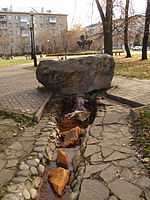Don (river)
[8][9][10] In the Book of Jubilees, it is mentioned as being part of the border, beginning with its easternmost point up to its mouth, between the allotments of the sons of Noah, that of Japheth to the north and that of Shem to the south.Tanais appears in ancient Greek sources as both the name of the river and of a city on it, situated in the Maeotian marshes.[16] While the lower Don was well known to ancient geographers, its middle and upper reaches were not mapped with any accuracy before the gradual conquest of the area by the Tsardom of Russia in the 16th century.The fort stood on the left bank of the Don, about 34 kilometres (21 mi) from the modern town of Dankov, until 1568, when it was destroyed by the Crimean Tatars, but was soon restored at a better fortified location.Mercator shows Mtsensk (Msczene) as a great city on this waterway, suggesting a system of canals connecting the Don with the Zusha (Schat) and Upa (Uppa) centered on a settlement Odoium, reported as Odoium lacum (Juanow ozero)[20] in the map made by Baron Augustin von Mayerberg, leader of an embassy to the Tsardom of Russia in 1661.[22] In order to improve shipping conditions in the lower reaches of the Don, the waterway authorities support plans for one or two more low dams with locks.

Don River (disambiguation)Voronezh OblastRussianRussiaTula OblastRyazan OblastLipetsk OblastVolgograd OblastRostov OblastVoronezhRostov-on-DonNovomoskovskSea of AzovRiver systemBityugKhopyorMedveditsaIlovlyaManychKrasivaya MechaBystraya SosnaTikhaya SosnaChyornaya KalitvaSeversky DonetsromanizedCentral RussiaSouthern RussiaRussia's largest riversByzantine EmpireDnieper basinestuarywest south-westVolga–Don CanalAvestanKurgan hypothesisProto-Indo-EuropeansSouthernBook of Jubileessons of NoahJaphethScythiansTanaisMaeotian marshesPlutarchAmazonsGreek mythologyBlack DeathTsardom of RussiaDon CossacksRyazanDankovCrimean TatarsMercatorJoan BlaeuMtsenskAugustin von MayerbergAnd Quiet Flows the DonMikhail Aleksandrovich SholokhovstanitsaVeshenskayaCaspian SeaBaltic SeaTsimlyansk ReservoirBagayevsky DistrictAksaysky DistricttributariesNepryadvaVedugaOseredTemernikDon goatMikhail SholokovRostov railway drawbridgeT and O mapStraboGeographicaDavies, NormanMercator, GerardusMassa, IsaacKropotkin, Peter AlexeivitchEncyclopædia BritannicaRivers of Russiadrainage basinBarents SeaWhite SeaArctic OceanIokangaMalaya BelayaNautsiyokiNorthern DvinaPinegaSukhonaUftyugaVychegdaYomtsaPechoraVarzugaVoronyaOredezhPlyussaŠešupėIzhoraPregolyaAngrapaInstruchSestraWestern DvinaPolotaKasplyaLake PeipusVelikayaKukhvaLake LadogaVolkhovTigodaVisheraVuoksiVolchyaLake IlmenPolistBerezaykaPeretnaShelonLake OnegaAndomaVytegra